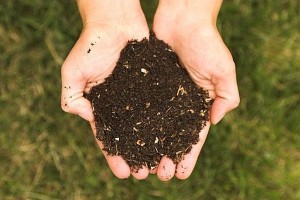OrganicFoodee gardeners know that home-cooked food creates home-made food waste, and this stuff can be turned into fabulous organic compost for your garden.
Composting waste food is easy peasy when you know how. All you need to do is layer your compost pile lasagna-style… one ‘green’ layer food waste, one ‘brown’ layer of brown leaves or paper, one thin layer of soil… one ‘green’ layer of food waste, one ‘brown’ layer of brown leaves or paper, one thin layer of soil… again and again, all the way to the top of the pile. The main thing to know is exactly what kinds of food waste is good to include, and what stuff is going to spoil the fun. The brown layer can be dead leaves, torn up cardboard boxes, or old newspapers as long as they’re printed with vegetable inks (the New York Times is, I think also The Independent in the UK). The soil layer is thinner than the green and brown layers, and is there to add tiny soil microbes into the layers. Ultimately, what we’re doing is creating an awesome home for the soil microbes to live so they get busy with eating the vegetable spread you’re providing and in doing so, break it all down into a beautiful, light, nutrient-rich soil.
All of this composting can take place in a fancy structure or simply in a round of chicken wire. It’s up to you how elaborate the compost bin are is, but really, it’s basically an aesthetic design thing. As long as the compost materials are contained enough to get to know each other, and as long as air can circulate around the pile so it doesn’t get moldy, your soil microbes aren’t a fussy bunch. They’re just as happy living in chicken wire as they are in a fancy place. But, if you’d like to see a sharp-looking bin in your garden instead of something potentially more unsightly, there are a ton of ready-made compost bins that can do the job.
Okay, here’s my definitive guide to which kitchen scraps are destined for composting and which aren’t.
COMPOST INGREDIENTS
1. Do not try to compost these things:
Meat
Dairy
Fats
Bones
In theory, there are advanced methods for composting these items, but for now, do not ever add these things to your regular compost pile.
2. Compost loves fruit and vegetables, and is also very happy to have some grains and bread.
3. The main ingredients in compost waste are raw fruit and vegetable waste, but it’s also great to include:
Coffee grounds
Tea bags, with the paper but no staples or string
Citrus peel and pulp from organic fruit
Bread and toast (even if it’s spread with a little butter)
Cooked grains, e.g. rice and pasta
Cooked fruit and vegetable waste
Greens
Cucumber and zucchini (these seeds aren’t mature, so no problem with them sprouting)
4. Don’t include anything hard that would be super difficult to break down, e.g:
avocado stones
mango stones
pineapple tops
5. No fruit or vegetable skins from non-organic produce, as they may be covered in a layer of pesticides that would then be in the compost, e.g:
lemon rind from non-organic lemons
pineapple rind from non-organic pineapples
6. No fruit or vegetable waste containing growable seeds, as they could grow in the compost and make baby plants… I’ve seen it happen many times! Wasted cooked seeds is fine, like sesame seeds baked in a piece of bread crust, but don’t throw any raw seeds into the compost like these:
tomato seeds
pepper cores with seeds
melon seeds
raw peas and beans
lemon pips
etc
7. Cut big chunky waste into small compostable pieces, i.e. nothing thicker than an inch maximum, nothing longer that 3 inches, e.g.
broccoli stems
pineapple cores
thick asparagus ends
whole spoiled fruit
corn cobs
8. Cut roots and tubers into pieces so they also won’t grow in the compost, e.g.
leek roots
onion bulbs
potatoes
9. Remove any metal or plastic from the kitchen waste, e.g.
tag staples and strings from tea bags
metal ties from greens
plastic stickers on fruits and veggies, including certified organic stickers!
10. If you’re in a rush, you can try adding some compost starter to the pile, and also you can try turning the pile occasionally to speed things up. But personally, I’m never in a rush for compost, as there will always be a need for great soil nutrients however fast or slow nature is with each compost pile. I prefer to let the process take place at it’s own pace, and I have a hunch the finished compost may be richer in nutrients if it’s a slower process to make.
Please let us know what you think by leaving a comment...
Like this page? Please link to us and let the world know!





I always read food related blogs, but your blog contains very nice information about vegetarian and non vegetarian meals comparision to others.
Posted by Indian Restaurant London on 26th January 2011 at 10:42 pm | Permalink
I read some contents in this blog. It’s contents contains more information about vegetarian and non vegetarian meals.
Posted by Indian Takeaway London on 27th January 2011 at 12:34 am | Permalink